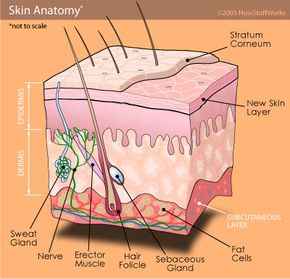If senior superlatives were given out to human organs, the heart would probably win "hardest working," the lungs would garner "most athletic" and the brain would end up with "most intelligent" (no surprise there). But what would the skin be noted for? Our guess is "most underappreciated" -- not to mention "best dressed."
For an underappreciated organ, skin takes up a lot of space. It's the body's largest organ, and if you were to stretch out the skin of the average adult, it would cover 22 square feet (2 square meters, or a little bigger than a twin bed) and weigh 8 pounds (3.6 kilograms) [source: National Geographic]. And can you imagine what we'd look like without that 22 square feet of skin to hold in our insides? Your muscles, bones and organs would all be exposed (and rather messy).
Advertisement
Besides keeping us nicely packaged, skin performs a host of important functions that are crucial for overall bodily health. Think of your skin as a protective covering that shields your body from germs. It's filled with white blood cells that are rigged to attack any invading harmful bacteria. Signals sent from your skin sound the alarm for your body's immune system to launch into action when germs have made entry.
Skin also helps regulate your body temperature. Blood vessels in the skin contract and dilate depending upon the outside temperature so that our bodies remain near 98.6 degrees F (37 degrees Celsius). When it's cold outside, blood vessels contract to keep the blood near the surface of your skin from becoming too cool. When it's hot outside, the same blood vessels expand to encourage heat loss, and you begin to sweat.
In addition to these vital jobs, skin provides us with the essential human experience of touch. Nerve endings in your skin send signals to the brain to communicate the sensations you're feeling: heat, cold, pain, pressure, texture. If it weren't for your skin and your nerves, you'd miss out on all the things that feel so good to the touch.
Now that you know why you should appreciate this special organ, let's find out what skin is made of.
Advertisement





